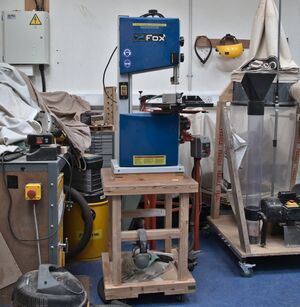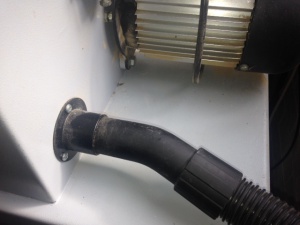Band Saw
![]() Warning! This page is out of date. This page references the small bandsaw (we have a bigger one). It also lacks an equipment box
Warning! This page is out of date. This page references the small bandsaw (we have a bigger one). It also lacks an equipment box

We have a Fox F28-186 band saw (like this one here)
The Basics
- Motor 370w
- Table dimensions 340x340mm
- Table tilt angle 0-45degrees
- Max cutting capacity throat 254mm
- Max cutting capacity-height 150mm
Please attach the shop-vac nozzle to the dust extraction port at the back of the bandsaw - this reduces the amount of dust thrown around the workshop.

Safety
- This is a finger removing machine - treat it with serious respect.
- Ensure guards are in place.
- Use a push stick if you need to push the work anywhere near the blade.
Spares
The machine will take 1820mm blades 3-12.8mm deep.
Replacement blades are available from CPC with the following part numbers:
- TL15172 (6mm)
- TL15173 (10mm)
- TL15174 (12mm)
Risk assessment for use of Band Saw.
Hazards.
- 1) Clothes becoming entangled.
- 2) Wood dust inhalation.
- 3) Removing workpiece with machine running breaks blade and causes projectile injury
- 4) Loss of fingers.
- 5) Loss of limb / hand.
- 6) Damage to eyes from particles
Persons at risk.
- Operator.
- Persons nearby.
Initial assessment of risk.
| Hazard identified | Severity | Probability | Risk Factor |
| Clothes becoming entangled | 3 | 2 | 6 |
| Wood dust inhalation | 2 | 3 | 6 |
| Removing workpiece with machine running breaks blade and causes projectile injury | 2 | 4 | 8 |
| Loss of fingers | 3 | 3 | 9 |
| Loss of limb / hand | 4 | 2 | 8 |
| Damage to eyes from particles | 3 | 3 | 9 |
Control measures.
- Users will be required to demonstrate competence to use the machine safely.
- Safety glasses will be worn.
- Keep hands away from the saw
- Do not remove workpiece from curved cuts with machine running
- Ear protection will be worn.
- Dust mask will be worn.
- Tie back long hair and secure loose clothing.
Final assessment of risk
| Hazard identified | Severity | Probability | Risk Factor |
| Clothes becoming entangled | 3 | 1 | 3 |
| Wood dust inhalation | 2 | 3 | 6 |
| Removing workpiece with machine running breaks blade and causes projectile injury | 2 | 2 | 4 |
| Loss of fingers | 3 | 1 | 3 |
| Loss of limb / hand | 4 | 1 | 4 |
| Damage to eyes from particles | 3 | 1 | 3 |
Points system
| Hazard severity | Points Rating | Definition |
| Nil | 1 | Very minor injury, bruise, graze, no risk of disease. |
| Slight | 2 | Minor injury, which would allow the individual to continue work after first aid treatment on site or at a local surgery. The duration of the stoppage or treatment is such that the normal flow of work is not seriously interrupted. |
| Moderate | 3 | Temporary disability causing injury or disease capable of keeping an individual off work for three days or more and reportable under RIDDOR |
| High | 4 | Causing death, serious injury or permanent disability to an individual. |
| Very high | 5 | Causing multiple deaths and widespread destruction eg. fire, building collapse. |
| Hazard likelihood | Points Rating | Definition |
| Remote possibility | 1 | There is really no risk present. Only under freak conditions could there be any possibility of an accident or illness. All reasonable precautions have been taken - This should be the normal state of the workplace. |
| Unlikely | 2 | This incident or illness might occur but the probability is low and the risk minimal. |
| Possible | 3 | The accident may occur if additional factors precipitate it, but it is unlikely to happen without them. |
| Highly likely | 4 | Will happen more often than not. Additional factors could precipitate an incident but it is still likely to happen without this additional factor. |
| Inevitable | 5 | If the work continues as it is, there is almost 100% certainty that an accident will happen, for example:
A broken stair or broken rung on a ladder Bare, exposed electrical conductors Unstable stacks of heavy boxes |
| Risk Rating Score | Definition | Action |
| 1 to 4 | Low | No action required |
| 5 to 9 | Moderate | Reduce risks if reasonably practicable |
| 10 to 15 | High Risk | Priority action to be undertaken |
| 16 to 25 | Unacceptable | Action must be taken IMMEDIATELY |